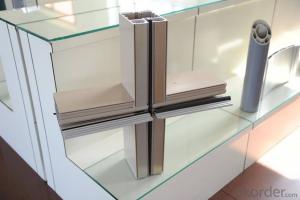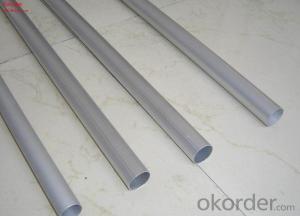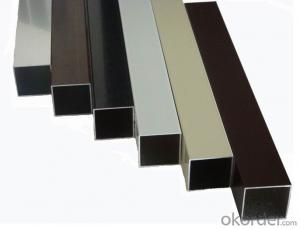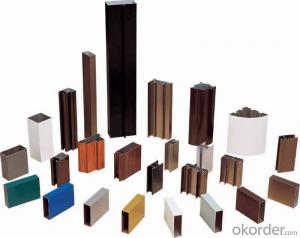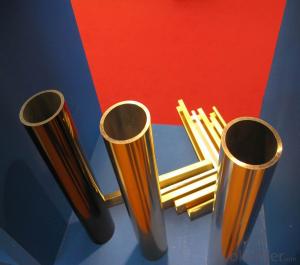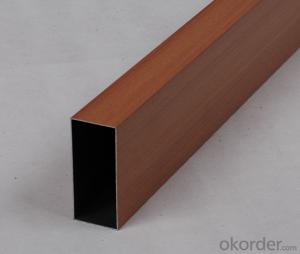T-Slotted Structural Aluminum Profiles - Coated Aluminum Square Tubes for Furniture
- Loading Port:
- Shanghai
- Payment Terms:
- TT OR LC
- Min Order Qty:
- 5 m.t.
- Supply Capability:
- 1000 m.t./month
OKorder Service Pledge
OKorder Financial Service
You Might Also Like
Name:aluminum tube&aluminum pipe
Material | 1000series,2000series,3000series.... |
Temper | T4,T5,T6 |
ISO Certificate | ISO9001:2008,SGS |
Size | The size are available in accordance with customers' options. |
Mill finish, Powder Coating, Anodizing, Sandblasting Anodizing, | |
Surface Processing | Cataphoresis, Sandblasting Cataphoresis, Wooden Print etc. |
Shape | round pipe |
Use | Building,Machine,Decoration,etc |
Color | Silver,Golden,Black,Red,Blue a,etc |
Packing: | Export sea worthy package |
Delivery: | Within 30 days after receiving 30%T/T of deposit or L/C |
MOQ: | 1 Metric Ton/Metric Tons |
Price terms: | FOB, CFR, CIF |
Payment terms: | T/T, L/C |
Application | aluminum pipe applies to Structural use ,roofing, commercial use, household appliance, industry, family etc |
Quality control: | a)Mill Test Certificate is supplied with shipment. b)Third party inspection is highly welcomed. |
- Q: What are the manufacturers of aluminum profiles in Jiangsu and Jiangyin?
- Jiangyin aluminum manufacturer, including aluminum, aluminum, cell Longding Xieji Xinyu aluminum, aluminum, aluminum, aluminum Donghua Jianbang started earlier, larger scale. Their market is mainly in East china.
- Q: Explain how aluminum profiles contribute to the energy efficiency of a building.
- <p>Aluminum profiles significantly enhance the energy efficiency of a building through several mechanisms. They are lightweight yet strong, reducing the overall weight of the structure and the energy required for construction. Their excellent thermal conductivity allows for efficient heat transfer, which can be managed with proper insulation to reduce heat loss. Aluminum profiles also facilitate better window and door sealing, minimizing drafts and heat leakage. Additionally, their high reflectivity can help in reflecting solar heat, reducing the need for cooling. Lastly, aluminum profiles can be used in the construction of solar panels and other renewable energy systems, further contributing to a building's energy efficiency.</p>
- Q: 6063 aluminum manufacturers fail to notice how to write a written report
- Hello!You can search the Internet for unqualified written reports, and see if there are similar onesYou see, you sign the contract, which has not marked this point, say how to deal with substandard, you just need to copy the above, make a little change on the lineAsk if your manufacturer has a template. How do you write it?In fact, this is not what the provisions of how to write, as long as the two agreed to make things clear, double admit something on the line, cover double seal, all right, hope to be able to help you, thank you for the adoption.
- Q: Explain the various methods used to install aluminum profiles in construction projects.
- <p>There are several methods to install aluminum profiles in construction: 1. Bolting: Aluminum profiles can be secured with bolts and nuts, providing a strong and adjustable connection. 2. Welding: For permanent and rigid connections, aluminum profiles can be welded together. 3. Adhesive bonding: Using specialized adhesives, aluminum profiles can be bonded together for a secure fit. 4. Clipping: Some profiles come with clip-on connectors that allow for quick and easy assembly. 5. Screwing: Self-tapping screws can be used to join aluminum profiles, providing a strong hold without the need for pre-drilled holes. 6. Mortise and tenon: A traditional woodworking joint that can be adapted for aluminum profiles, creating a tight and secure fit. Each method has its advantages and is chosen based on the specific requirements of the construction project.</p>
- Q: Are aluminum profiles suitable for the furniture industry?
- Yes, aluminum profiles are suitable for the furniture industry. They are lightweight, durable, and have a sleek and modern appearance. Additionally, aluminum profiles can be easily customized and shaped into various designs and sizes, making them versatile for different furniture applications. They are also resistant to corrosion and weathering, making them suitable for both indoor and outdoor furniture.
- Q: What are the different types of gaskets used with aluminum profiles?
- There are various types of gaskets used with aluminum profiles, including rubber gaskets, EPDM gaskets, silicone gaskets, neoprene gaskets, and PVC gaskets. These gaskets are chosen based on their specific properties and suitability for different applications, such as weather sealing, sound insulation, thermal insulation, or vibration dampening.
- Q: What industries commonly use aluminum profiles?
- Aluminum profiles find wide applications in various industries, owing to their unique properties and versatility. The construction industry is one of the major sectors that extensively employs aluminum profiles. These profiles are utilized in the construction of windows, doors, curtain walls, and other architectural components. The lightweight nature of aluminum makes it an ideal preference for such applications, as it reduces the burden on the building structure. Similarly, the automotive industry heavily relies on aluminum profiles for manufacturing purposes. These profiles are used in the production of car frames, body panels, and components, offering an exceptional strength-to-weight ratio and corrosion resistance. By incorporating aluminum profiles, the overall weight of vehicles is reduced, resulting in improved fuel efficiency and performance. Aerospace manufacturing is another sector that heavily depends on aluminum profiles. These profiles are employed in constructing aircraft frames, wings, and fuselages. Their high strength and durability make them suitable for enduring the challenges of flight, while their lightweight characteristic contributes to fuel efficiency. The electronics industry also finds great utility in aluminum profiles. They are used in the production of heat sinks, aiding in the dissipation of heat from electronic components. Aluminum's excellent thermal conductivity ensures effective heat transfer, safeguarding sensitive electronic devices from damage. Furthermore, the furniture industry adopts aluminum profiles extensively in the production of lightweight and durable furniture pieces. These profiles are used to construct frames for chairs, tables, shelves, and various other furniture items. Their corrosion resistance and aesthetic appeal make them a preferred choice for both indoor and outdoor furniture. In conclusion, industries such as construction, automotive, aerospace, electronics, and furniture commonly embrace aluminum profiles due to their lightweight nature, strength, corrosion resistance, and versatility. These profiles play a vital role in enhancing the performance, efficiency, and durability of products in these industries.
- Q: Can aluminum profiles be used in telecommunications infrastructure?
- Yes, aluminum profiles can be used in telecommunications infrastructure. Aluminum is a lightweight and durable material that offers excellent structural integrity and corrosion resistance, making it suitable for various applications within telecommunications infrastructure, such as antenna towers, cable trays, and equipment racks. Additionally, aluminum profiles can be easily customized and fabricated to meet specific requirements, making them a versatile choice for telecom installations.
- Q: Can aluminum profiles be used for staircase handrails?
- Yes, aluminum profiles can be used for staircase handrails. Aluminum is a popular choice for handrails due to its durability, lightweight nature, and corrosion-resistant properties. It can be easily shaped into various designs and provides a sleek and modern look to staircases. Additionally, aluminum profiles can be customized to meet specific design and safety requirements, making them suitable for staircase handrails.
- Q: I have a product in the aluminum above the oxidation of 20 through the hole, that is so, good heat dissipation, I do not know, right, before oxidation, punching OK?
- This has nothing to do with the thermal conductivity. The processing of aluminum before oxidation is very good. After oxidation, the alumina is a dense layer of oxide to protect the internal aluminum from corrosion, and the drilling is easy to remove the oxide!
Send your message to us
T-Slotted Structural Aluminum Profiles - Coated Aluminum Square Tubes for Furniture
- Loading Port:
- Shanghai
- Payment Terms:
- TT OR LC
- Min Order Qty:
- 5 m.t.
- Supply Capability:
- 1000 m.t./month
OKorder Service Pledge
OKorder Financial Service
Similar products
Hot products
Hot Searches
Related keywords











